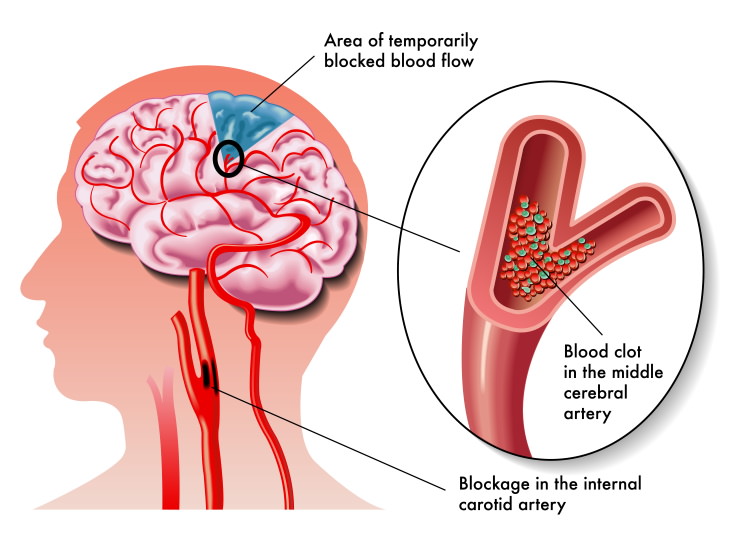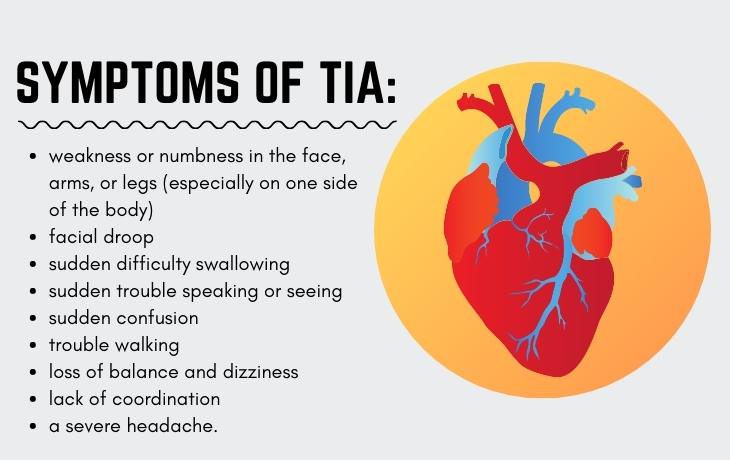The Signs of a Ministroke (TIA) and Ways to Prevent It
Have you ever heard of the word
“ministroke”? The proper term for this health emergency is transient
ischemic attack (or simply TIA), and it occurs when blood flow is
temporarily cut off to a part of the brain. Ministrokes usually resolve
within a day and do not inflict lasting damage to the brain.
“Since it doesn’t cause permanent damage, it’s often ignored. But this
is a big mistake. TIAs may signal a full-blown stroke ahead,” warns the
American Stroke Association. If you or someone you know is experiencing
symptoms of TIA, never turn a blind eye and get urgent medical help.
Let’s investigate how a ministroke differs from a full-blown stroke,
learn about the signs of TIA, and what you can do to prevent it.
How is a ministroke different from a stroke?

TIA and stroke are two sides of the same
coin. The only real difference between a ministroke and a full-blown
stroke is time. During a ministroke, the blockage of the blood vessel in
the brain is brief enough that it doesn’t cause lasting damage to the
brain tissue. In a stroke, blood flow is cut off long enough for such
damage to occur.
Due to this causal similarity, the signs and symptoms of TIA are
identical to that of stroke. However, the duration of symptoms is
different. In a ministroke, the neurological symptoms last anywhere from
a few minutes and up to 24 hours. The symptoms and complications of a
stroke last for a day or more and may never clear up.
The exact symptoms of a ministroke are very individual, it all depends
on which part of the brain is depleted of blood supply. We list the
common symptoms of both ministroke and stroke as per the CDC in the
image below, and you can read more on the topic in our article titled
What Can You Do to Save Yourself in Case of a Stroke?

All things considered, a ministroke should
always be treated as a stroke because only a doctor can distinguish
between the two and administer proper treatment. If you or someone you
know is experiencing any of these symptoms, seek immediate medical
attention. If the symptoms go away by the time the doctor arrives,
describe your symptoms and ask for a more thorough evaluation.
Those diagnosed with a ministroke in the past should never disregard it
because TIA can signal an imminent stroke. According to the CDC, “More
than a third of people who have a TIA and don’t get treatment have a
major stroke within 1 year. As many as 10% to 15% of people will have a
major stroke within 3 months of a TIA.”
The causes of TIA
TIAs and stroke have the same root cause — a blood clot blocking a blood
vessel in the brain. This usually occurs as a result of:
Embolism - a blood clot travels from another part of the body (e.g.
the heart) to the brain.
Atherosclerosis - fatty plaque builds up in a blood vessel,
obstructing blood flow. Those suffering from high blood pressure are at a
high risk of atherosclerosis and therefore ministroke and stroke too.
What puts you at risk of TIA?
A number of factors increase the risk of stroke and ministroke, and not
all of them are under our control. Unfortunately, the risk of TIA and
stroke increases with age, so we all have a chance to develop one of
these conditions over time. Women are also more likely to experience a
ministroke and stroke than men. Everyone with a family member who has
had a stroke, no matter their age or gender, has a higher risk of
developing TIA and stroke. Lastly, diabetes sufferers are more likely to
experience TIA and stroke than non-diabetics.
On the bright side, there are many risk factors of ministroke you can
eliminate from your life. These are:
Not enough physical activity can
contribute to TIA and stroke.
Smoking - cigarette smoke damages the cardiovascular system, which
raises the risk of ministroke and stroke.
High cholesterol - a diet high in trans fat and saturated fat (fatty
cuts of red meat, fast food, and anything fried) makes your levels of
LDL “bad” cholesterol surge, which then raises the risk of ministroke
and stroke.
What can you do if someone nearby is having a stroke?
Symptoms of ministroke and stroke tend to arise suddenly and
unexpectedly, and you need to act fast and call an ambulance as soon as
possible.
The word “FAST” also helps you remember the things you should
pay attention to if you suspect a stroke:
Face - look at the person and ask them to smile. If one of the sides
of the face droops, that points to a stroke.
Arms - ask the person to raise their arms. If the arms are uneven
and one arm drifts downward, that is a sign of a stroke.
Speech - make the person repeat any simple phrase. Unorganized,
strange, or slurred speech is a symptom of stroke.
Time - If you notice any of these symptoms, call 911(or your local
emergency service) immediately.
Treatment and Prevention of TIA
A patient who has experienced TIA will
undergo a thorough medical examination with the goal to identify the
root cause of the issue and prevent a future stroke. A neurological
examination, brain imaging, and blood-work will most likely be required
to diagnose the issue.
The treatment will depend on the results of the medical examinations,
but it nearly always involves changing your lifestyle to manage
atherosclerosis and prevent a future ministroke and stroke.
You can
follow the same tips to prevent TIA:
1. Seek medical help to manage high blood pressure, diabetes, or high
cholesterol if you suffer from any of these conditions.
2. If you smoke, it’s necessary to stop. If someone in your household
smokes, avoid secondhand smoke.
3. Consume antioxidant-rich fruits, vegetables, and whole grains and
avoid foods high in trans fats and saturated fats.
4. Be physically active and exercise on a regular basis.
5. Limit your alcohol consumption as much as you can.